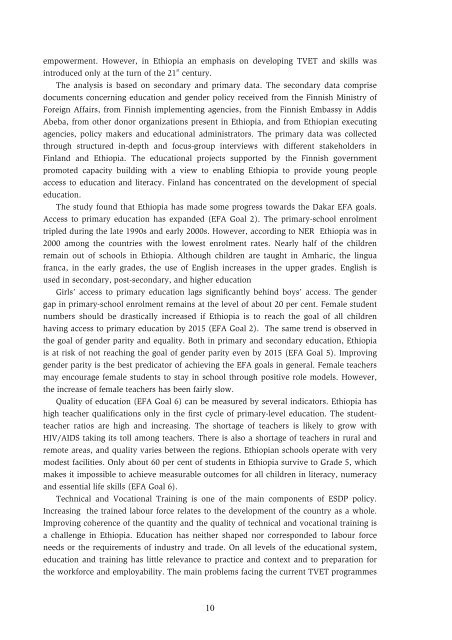Education and Training in Ethiopia An Evaluation of Approaching EFA Goals
Education and Training in Ethiopia - Koulutuksen tutkimuslaitos
Education and Training in Ethiopia - Koulutuksen tutkimuslaitos
- No tags were found...
You also want an ePaper? Increase the reach of your titles
YUMPU automatically turns print PDFs into web optimized ePapers that Google loves.
empowerment. However, <strong>in</strong> <strong>Ethiopia</strong> an emphasis on develop<strong>in</strong>g TVET <strong>and</strong> skills was<strong>in</strong>troduced only at the turn <strong>of</strong> the 21 st century.The analysis is based on secondary <strong>and</strong> primary data. The secondary data comprisedocuments concern<strong>in</strong>g education <strong>and</strong> gender policy received from the F<strong>in</strong>nish M<strong>in</strong>istry <strong>of</strong>Foreign Affairs, from F<strong>in</strong>nish implement<strong>in</strong>g agencies, from the F<strong>in</strong>nish Embassy <strong>in</strong> AddisAbeba, from other donor organizations present <strong>in</strong> <strong>Ethiopia</strong>, <strong>and</strong> from <strong>Ethiopia</strong>n execut<strong>in</strong>gagencies, policy makers <strong>and</strong> educational adm<strong>in</strong>istrators. The primary data was collectedthrough structured <strong>in</strong>-depth <strong>and</strong> focus-group <strong>in</strong>terviews with different stakeholders <strong>in</strong>F<strong>in</strong>l<strong>and</strong> <strong>and</strong> <strong>Ethiopia</strong>. The educational projects supported by the F<strong>in</strong>nish governmentpromoted capacity build<strong>in</strong>g with a view to enabl<strong>in</strong>g <strong>Ethiopia</strong> to provide young peopleaccess to education <strong>and</strong> literacy. F<strong>in</strong>l<strong>and</strong> has concentrated on the development <strong>of</strong> specialeducation.The study found that <strong>Ethiopia</strong> has made some progress towards the Dakar <strong>EFA</strong> goals.Access to primary education has exp<strong>and</strong>ed (<strong>EFA</strong> Goal 2). The primary-school enrolmenttripled dur<strong>in</strong>g the late 1990s <strong>and</strong> early 2000s. However, accord<strong>in</strong>g to NER <strong>Ethiopia</strong> was <strong>in</strong>2000 among the countries with the lowest enrolment rates. Nearly half <strong>of</strong> the childrenrema<strong>in</strong> out <strong>of</strong> schools <strong>in</strong> <strong>Ethiopia</strong>. Although children are taught <strong>in</strong> Amharic, the l<strong>in</strong>guafranca, <strong>in</strong> the early grades, the use <strong>of</strong> English <strong>in</strong>creases <strong>in</strong> the upper grades. English isused <strong>in</strong> secondary, post-secondary, <strong>and</strong> higher educationGirls’ access to primary education lags significantly beh<strong>in</strong>d boys’ access. The gendergap <strong>in</strong> primary-school enrolment rema<strong>in</strong>s at the level <strong>of</strong> about 20 per cent. Female studentnumbers should be drastically <strong>in</strong>creased if <strong>Ethiopia</strong> is to reach the goal <strong>of</strong> all childrenhav<strong>in</strong>g access to primary education by 2015 (<strong>EFA</strong> Goal 2). The same trend is observed <strong>in</strong>the goal <strong>of</strong> gender parity <strong>and</strong> equality. Both <strong>in</strong> primary <strong>and</strong> secondary education, <strong>Ethiopia</strong>is at risk <strong>of</strong> not reach<strong>in</strong>g the goal <strong>of</strong> gender parity even by 2015 (<strong>EFA</strong> Goal 5). Improv<strong>in</strong>ggender parity is the best predicator <strong>of</strong> achiev<strong>in</strong>g the <strong>EFA</strong> goals <strong>in</strong> general. Female teachersmay encourage female students to stay <strong>in</strong> school through positive role models. However,the <strong>in</strong>crease <strong>of</strong> female teachers has been fairly slow.Quality <strong>of</strong> education (<strong>EFA</strong> Goal 6) can be measured by several <strong>in</strong>dicators. <strong>Ethiopia</strong> hashigh teacher qualifications only <strong>in</strong> the first cycle <strong>of</strong> primary-level education. The studentteacherratios are high <strong>and</strong> <strong>in</strong>creas<strong>in</strong>g. The shortage <strong>of</strong> teachers is likely to grow withHIV/AIDS tak<strong>in</strong>g its toll among teachers. There is also a shortage <strong>of</strong> teachers <strong>in</strong> rural <strong>and</strong>remote areas, <strong>and</strong> quality varies between the regions. <strong>Ethiopia</strong>n schools operate with verymodest facilities. Only about 60 per cent <strong>of</strong> students <strong>in</strong> <strong>Ethiopia</strong> survive to Grade 5, whichmakes it impossible to achieve measurable outcomes for all children <strong>in</strong> literacy, numeracy<strong>and</strong> essential life skills (<strong>EFA</strong> Goal 6).Technical <strong>and</strong> Vocational <strong>Tra<strong>in</strong><strong>in</strong>g</strong> is one <strong>of</strong> the ma<strong>in</strong> components <strong>of</strong> ESDP policy.Increas<strong>in</strong>g the tra<strong>in</strong>ed labour force relates to the development <strong>of</strong> the country as a whole.Improv<strong>in</strong>g coherence <strong>of</strong> the quantity <strong>and</strong> the quality <strong>of</strong> technical <strong>and</strong> vocational tra<strong>in</strong><strong>in</strong>g isa challenge <strong>in</strong> <strong>Ethiopia</strong>. <strong>Education</strong> has neither shaped nor corresponded to labour forceneeds or the requirements <strong>of</strong> <strong>in</strong>dustry <strong>and</strong> trade. On all levels <strong>of</strong> the educational system,education <strong>and</strong> tra<strong>in</strong><strong>in</strong>g has little relevance to practice <strong>and</strong> context <strong>and</strong> to preparation forthe workforce <strong>and</strong> employability. The ma<strong>in</strong> problems fac<strong>in</strong>g the current TVET programmes10




![to read the full report [pdf, Amharic] - Ethiopian Review](https://img.yumpu.com/52737829/1/190x245/to-read-the-full-report-pdf-amharic-ethiopian-review.jpg?quality=85)











